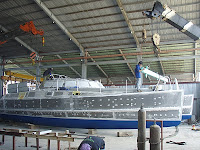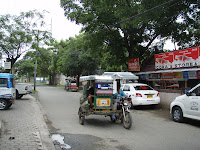Well, we are adjusting well to life in the
Philippines. We've found some good restaurants and eat out about half the time, paying a little less than US prices for excellent food. However, you can eat real cheap if you buy food from the street vendors. They serve warm stews (made fresh daily) from large pots and the locals can buy a meal for about 25 cents. This is important to many poor households since they don't have stoves and cook their rice over firewood.


The grocery stores are well stocked. We're fascinated by the many types of fish, both fresh and dried, that people use. There is good selection of fresh fruits and veggies available too, like jackfruit, pineapple, leafy greens and giant squashes. I made a vegetable stir fry the other night using Kang kong, the closest green to spinach I have found. I also wanted to use zucchini in the dish and bought something that looked liked it called sikwa. We looked it up on the internet and it's used for luffa sponges, but it tasted fine.
They sell the mos

t flavorful sweet mangoes year round that are delicious fresh but are also dried here and sold at home (look for Philippine brand dried mangoes at Costco). Here is a picture of a commercial mango tree. Each mango is individually wrapped to resist strong winds and insect pests such as the mango seed borer which will devour the flesh as well as the seed.
This is a pretty amazing corner of the world and very religious. We were in the market yesterday evening when everyone was asked to stop for a few minutes of prayer that they read over the loud speaker. Currently in front of the Catholic churches are banners describing the evils of birth control. For a country with serious overpopulation to celebrate a family welcoming it's 12th child seems a bit strange to us outsiders. The government is trying to pass a reproductive health bill that would provide free birth control for everyone. The church equates birth control with abortion and opposes it.
We are doing well  here, keeping busy putting out fires right and left at the yard and quickly learning the driving patterns that allow you to survive on the road. The weather here is hot and muggy, mid-eighties with pretty high humidity, but not nearly as bad as we expected. You just have to drink lots of water.
here, keeping busy putting out fires right and left at the yard and quickly learning the driving patterns that allow you to survive on the road. The weather here is hot and muggy, mid-eighties with pretty high humidity, but not nearly as bad as we expected. You just have to drink lots of water.
We take Sundays off along with the rest of the country. We went sailing July 17 with Tim Mumby, the designer of our boat, on his catamaran which he is just finishing at his beach boatyard. We easily did 8-9 knots into the wind in 10 knots of breeze, 11 knots on a reach sideways to the wind, and 8 knots going downwind. So, the boats really sail. It was great to experience what this effort will produce.
For recreation, we joined a walking group, called the Cebu Hash House Harriers, which is a branch of a world wide running/ drinking club popular with ex-pats. You walk or run a marked trail (hash marked) through countryside and villages and at the end you have drink some beer while attending a hash circle meeting, and maybe go to dinner together after.



We have enjoyed going on Hash runs here, they have given us a chance to see some of the countryside as well as city innards. We are trying to balance getting work done and enjoying the place.




We went on another Hash Run July 31 up in the hills above a development of million-dollar homes. Some had beautiful architectural monuments with expansive grounds, high-end cars parked out front and staff housing. To get to this area we had to drive through some places that are slums beyond the imagination of most people. Even more interesting were the informal settlements in the hills above this development. We walked through lots of tiny communities (5-10 huts) which had literally been carved out of the mountains. These are squatters who just move in and build a small house, farm a bit, raise chickens and pigs and settle in. They have no electricity, sewer system or other services. Water is about 500 vertical feet down the mountain on a narrow and slippery trail (about 1/4 mile long). Kids from 4 years old on were carrying water in all sorts of containers, from plastic coke bottles up to 3 gallon jerrycans from the stream at the bottom up the hill to their homes. Water quality looked to be very marginal. They live a very long ways from any store or source of any consumer goods, though undoubtedly in the next few years some small stores will develop. Everyone we saw was working hard just to survive, but also very friendly. Makes you really glad to be living where we do.



While people are poor here, they are happy. They live in extended families, take care of each other, are respectful of their elders and friendly. Filipinos are curious about foreigners and commonly ask personal questions like age, number of kids, and religion. I was in the apartment office last week and noticed they have a scale in both kilos and pounds on it, so I stepped onto it. All the office workers crowded around to see the result and this week they asked me if I had lost any weight-and I was able to say yes.
We see relatively limited tourism here and are beginning to understand why. There are a couple types of tourists in this part of the Philippines (and the rest as near as we can tell). It's an inexpensive destination from Asian countries. Many Japanese tourists come here for bargain scubadiving packages. It’s cheap, tropical and has pretty good diving. There are lots of what we would consider very low to mid-level dive resorts and a few sort of mid-to high level resorts. Cebu is also a popular place for South Koreans to come to learn English. It is much cheaper to study here than in western countries. The hotels have relatively low prices which is easy to understand when you realize that unskilled labor gets about $5.00 per day and skilled labor under $10.00 per day. Cheap labor makes it easier to run a resort or boarding school (or build a boat) but makes it harder for the young people from large families to get by.
Another type of tourist here is a western male interested in companionship. Men can make short or long term acquaintances by visiting relatively expensive "clubs" where they can hook up with girls for an evening or even a few weeks to months. The young women are lovely, pleasant and while we might be put off by the whole scene, are simply doing what they can to have a better life. In any case tourism as we view it from North America is pretty much non-existent here. It is an inexpensive place to retire though if you can accept the poverty and pollution.
 Pre-Launch Days
Pre-Launch Days









































